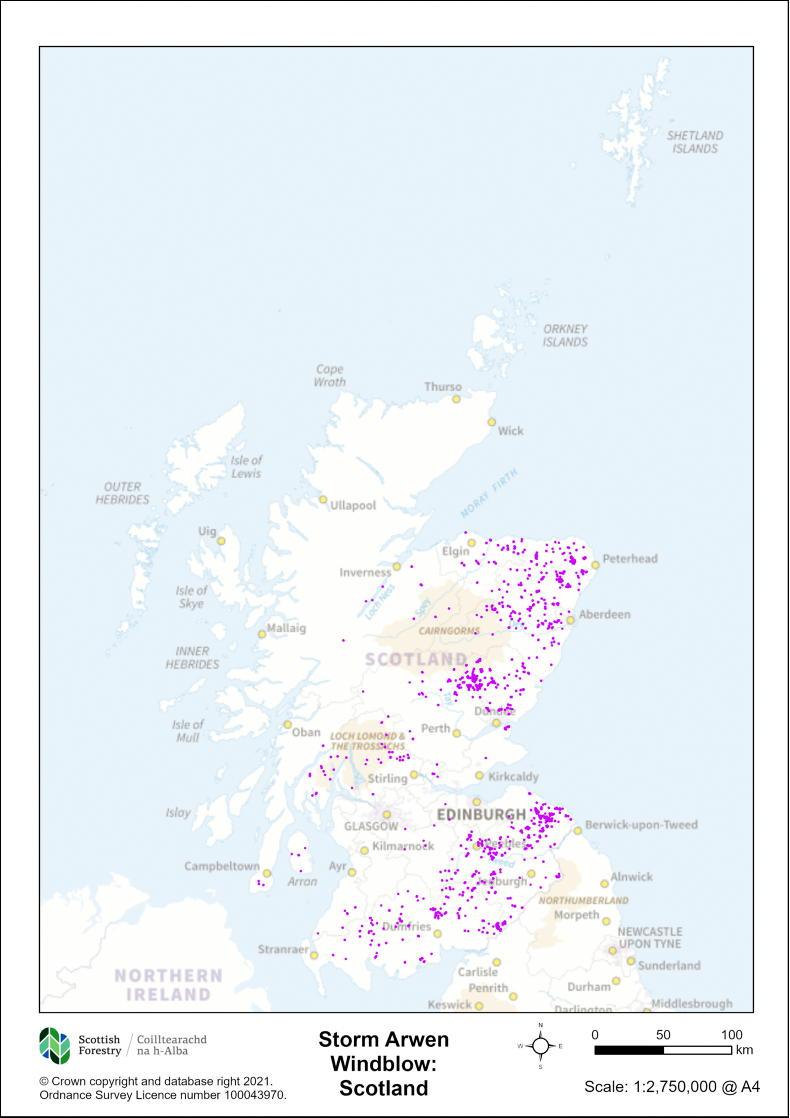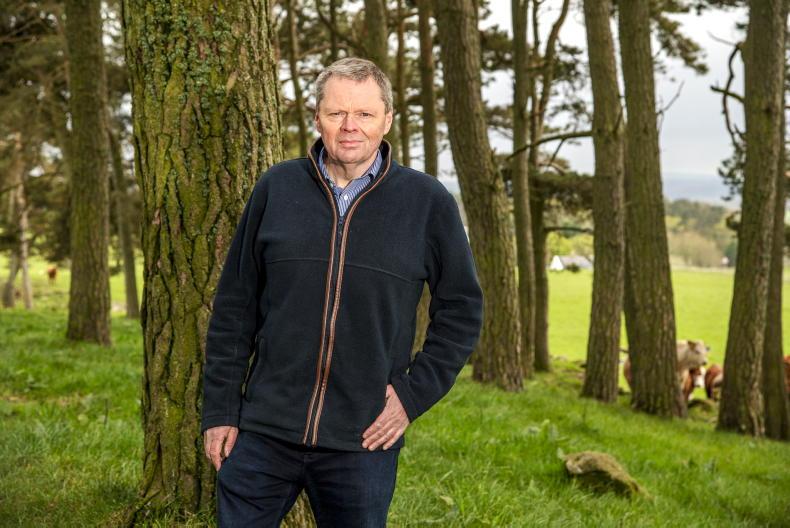Scottish farmers are calling on the government to stop large-scale forestry expansion on productive agricultural land.
NFU Scotland states that planting large areas of productive farmland erodes the nation’s food security. It believes much of the growth in recent times has been fuelled by non-agricultural businesses purchasing land for planting to offset carbon emissions and boost their green credentials.
The union wants to see integration between woodlands and farm businesses, “recognising the multiple benefits including enhanced biodiversity, alternative income streams, livestock shelter and silvopasture”.
NFU Scotland met recently with Cabinet secretary Mairi Gougeon, Minister Màiri McAllan and senior officials from Scottish government and Scottish forestry to discuss its growing concerns.
Complaints
NFU Scotland vice-president Andrew Connon said: “On a weekly, if not daily basis, members are contacting us from all parts of the country about the loss of productive Scottish agricultural land to wholesale forestry.

The winner of Tree of the Year 2021 is a lone hawthorn tree located in Kippford, Dalbeattie in Dumfries & Galloway.
“We accept that land use is never a straight choice and integrated land use is clearly a major part of reaching net zero targets, but we are equally clear that optimal land use is the only route to attaining multiple objectives, and that must include food production, climate change ambitions and biodiversity enhancement.
“As well as the existing legal safeguards that preserve Scotland’s very limited ‘prime’ agricultural land from wholesale tree planting, NFU Scotland believes the time is right for a more robust approach to screening planting applications on Scotland’s ‘productive’ agricultural land.
“Planting incentives and unregulated carbon markets are effectively eroding Scotland’s food security, adding to the risk of simply offshoring our emissions by increasing our reliability on imported products.
£69.5m for trees in Scotland
The new Scottish government’s budget is investing a further £69.5m in woodland creation and management. This cash will go towards the government’s target of 15,000ha of trees planted annually before growing to 18,000ha by 2024-25.
The rise in forestry spending has been welcomed by those in the sector. Stuart Goodall, chief executive of Confor, a UK forestry trade body, said: “I’m delighted to see the Scottish government putting the additional money on the table required to meet its commitment to expand sustainable woodland creation in Scotland.
“Scotland is planting 80% of all new woodland in the UK – and it is doing so with a clear purpose. Scotland’s tree planting locks up carbon while creating jobs and economic growth in rural areas, as well as providing the future supplies of wood we need to build new, zero carbon homes and much more.”
While those in the forestry sector are excited to grow the industry the ambitious targets have caused shortages in the supply chain. Growing trees for forestry takes nurseries between one and three years, which means long-term planning is needed to ensure supply for planting. Germination rates can vary from 100% to 20%, which is not known until relatively far into the production process.
There is also volatility in seed availability depending on the season. There can be a huge variation in the numbers of seed cast from trees from year to year.
Species like oak and spruce will traditionally have one very productive season setting seed, followed by a year of very poor collections. For example, very few acorns on trees in 2021 means oak trees will be scarce for the next two years.
Labour shortage is also a concern for nurseries. Craig Turner, CEO of Alba Trees, said: “Availability of labour is likely to be a significant barrier to increasing tree production – with 2021 being the most challenging year ever in this respect.”
Between sowing and dispatching for planting, plants need to be handled around five times.
Counting the cost
of storm ArwenOver one million cubic metres of timber have been lost through storm Arwen which equates to around 20% of Scotland’s annual timber harvest.
Furthermore, the value of windblown Scots pine will “quickly deteriorate” unless it can be felled “as soon as possible” according to industry experts.
High winds hitting 100mph blew down trees, blocked trails and roads, and caused extensive damage, particularly in Aberdeenshire, the Borders and Dumfriesshire.

Map of areas of forestry damaged by storm Arwen.
The full extent of the damage will not be known until satellite imagery can be analysed across the country.
Scots pines have to be harvested within six months to avoid the crop plummeting in value. The other species of tree which was badly damaged was Sitka spruce which has six months to a year before it deteriorates.
Jamie Farquhar, national manager for Scotland at Confor, said: “Species like Scots pine degrade quickly after windblow and trees that have snapped rather than completely blown over will have little or no value if they are not harvested quickly.”
Scottish farm budget at a glanceThe Scottish government’s budget will see £799.6m spent on agricultural support and rural economy payments for 2022-23. This is a drop of £4.4m compared to the 2021-22 budget.
Pillar I basic payments (BPS) have stayed the same at £282m. Also Pillar I Greening, coupled and other payments remain unchanged at £142m and £61m, respectively. Convergence payments will fall from £95.7m to £25.7m.
Agricultural transformation has been cut to £25m compared to £45m last year. Agri-environmental payments are similar to last year at £35.8m. The legacy of the EU Leader programme is getting £11.6m and Less Favoured Area Support Scheme £65.5m.
The animal health budget has gone up from £18.9m to £19.6m. Food industry support gets £10.5m and veterinary surveillance £4.9m.
Farmers sought for
business surveySAC Consulting, is looking for farmers to take part in the annual Scottish Farm Business Survey, in exchange for free financial and environmental reports.
Data collected from the survey covering livestock, dairy and arable farming has been producing national agricultural statistics since the 1930s.
Participation is voluntary, but in return farmers get a farm business report which allows them to compare their costs and productivity year on year for up to three years.
They also get a carbon audit in Agrecalc, which can be used for grant applications or to fulfil audits for commercial purposes, and an individual performance benchmark report which compares their figures to similar businesses.
For more information or to take part in the survey, please get in touch with Sascha Grierson at: Sascha.Grierson@sac.co.uk or 07557 661316.
Scottish farmers are calling on the government to stop large-scale forestry expansion on productive agricultural land.
NFU Scotland states that planting large areas of productive farmland erodes the nation’s food security. It believes much of the growth in recent times has been fuelled by non-agricultural businesses purchasing land for planting to offset carbon emissions and boost their green credentials.
The union wants to see integration between woodlands and farm businesses, “recognising the multiple benefits including enhanced biodiversity, alternative income streams, livestock shelter and silvopasture”.
NFU Scotland met recently with Cabinet secretary Mairi Gougeon, Minister Màiri McAllan and senior officials from Scottish government and Scottish forestry to discuss its growing concerns.
Complaints
NFU Scotland vice-president Andrew Connon said: “On a weekly, if not daily basis, members are contacting us from all parts of the country about the loss of productive Scottish agricultural land to wholesale forestry.

The winner of Tree of the Year 2021 is a lone hawthorn tree located in Kippford, Dalbeattie in Dumfries & Galloway.
“We accept that land use is never a straight choice and integrated land use is clearly a major part of reaching net zero targets, but we are equally clear that optimal land use is the only route to attaining multiple objectives, and that must include food production, climate change ambitions and biodiversity enhancement.
“As well as the existing legal safeguards that preserve Scotland’s very limited ‘prime’ agricultural land from wholesale tree planting, NFU Scotland believes the time is right for a more robust approach to screening planting applications on Scotland’s ‘productive’ agricultural land.
“Planting incentives and unregulated carbon markets are effectively eroding Scotland’s food security, adding to the risk of simply offshoring our emissions by increasing our reliability on imported products.
£69.5m for trees in Scotland
The new Scottish government’s budget is investing a further £69.5m in woodland creation and management. This cash will go towards the government’s target of 15,000ha of trees planted annually before growing to 18,000ha by 2024-25.
The rise in forestry spending has been welcomed by those in the sector. Stuart Goodall, chief executive of Confor, a UK forestry trade body, said: “I’m delighted to see the Scottish government putting the additional money on the table required to meet its commitment to expand sustainable woodland creation in Scotland.
“Scotland is planting 80% of all new woodland in the UK – and it is doing so with a clear purpose. Scotland’s tree planting locks up carbon while creating jobs and economic growth in rural areas, as well as providing the future supplies of wood we need to build new, zero carbon homes and much more.”
While those in the forestry sector are excited to grow the industry the ambitious targets have caused shortages in the supply chain. Growing trees for forestry takes nurseries between one and three years, which means long-term planning is needed to ensure supply for planting. Germination rates can vary from 100% to 20%, which is not known until relatively far into the production process.
There is also volatility in seed availability depending on the season. There can be a huge variation in the numbers of seed cast from trees from year to year.
Species like oak and spruce will traditionally have one very productive season setting seed, followed by a year of very poor collections. For example, very few acorns on trees in 2021 means oak trees will be scarce for the next two years.
Labour shortage is also a concern for nurseries. Craig Turner, CEO of Alba Trees, said: “Availability of labour is likely to be a significant barrier to increasing tree production – with 2021 being the most challenging year ever in this respect.”
Between sowing and dispatching for planting, plants need to be handled around five times.
Counting the cost
of storm Arwen
Over one million cubic metres of timber have been lost through storm Arwen which equates to around 20% of Scotland’s annual timber harvest.
Furthermore, the value of windblown Scots pine will “quickly deteriorate” unless it can be felled “as soon as possible” according to industry experts.
High winds hitting 100mph blew down trees, blocked trails and roads, and caused extensive damage, particularly in Aberdeenshire, the Borders and Dumfriesshire.

Map of areas of forestry damaged by storm Arwen.
The full extent of the damage will not be known until satellite imagery can be analysed across the country.
Scots pines have to be harvested within six months to avoid the crop plummeting in value. The other species of tree which was badly damaged was Sitka spruce which has six months to a year before it deteriorates.
Jamie Farquhar, national manager for Scotland at Confor, said: “Species like Scots pine degrade quickly after windblow and trees that have snapped rather than completely blown over will have little or no value if they are not harvested quickly.”
Scottish farm budget at a glanceThe Scottish government’s budget will see £799.6m spent on agricultural support and rural economy payments for 2022-23. This is a drop of £4.4m compared to the 2021-22 budget.
Pillar I basic payments (BPS) have stayed the same at £282m. Also Pillar I Greening, coupled and other payments remain unchanged at £142m and £61m, respectively. Convergence payments will fall from £95.7m to £25.7m.
Agricultural transformation has been cut to £25m compared to £45m last year. Agri-environmental payments are similar to last year at £35.8m. The legacy of the EU Leader programme is getting £11.6m and Less Favoured Area Support Scheme £65.5m.
The animal health budget has gone up from £18.9m to £19.6m. Food industry support gets £10.5m and veterinary surveillance £4.9m.
Farmers sought for
business surveySAC Consulting, is looking for farmers to take part in the annual Scottish Farm Business Survey, in exchange for free financial and environmental reports.
Data collected from the survey covering livestock, dairy and arable farming has been producing national agricultural statistics since the 1930s.
Participation is voluntary, but in return farmers get a farm business report which allows them to compare their costs and productivity year on year for up to three years.
They also get a carbon audit in Agrecalc, which can be used for grant applications or to fulfil audits for commercial purposes, and an individual performance benchmark report which compares their figures to similar businesses.
For more information or to take part in the survey, please get in touch with Sascha Grierson at: Sascha.Grierson@sac.co.uk or 07557 661316.









 This is a subscriber-only article
This is a subscriber-only article










SHARING OPTIONS: